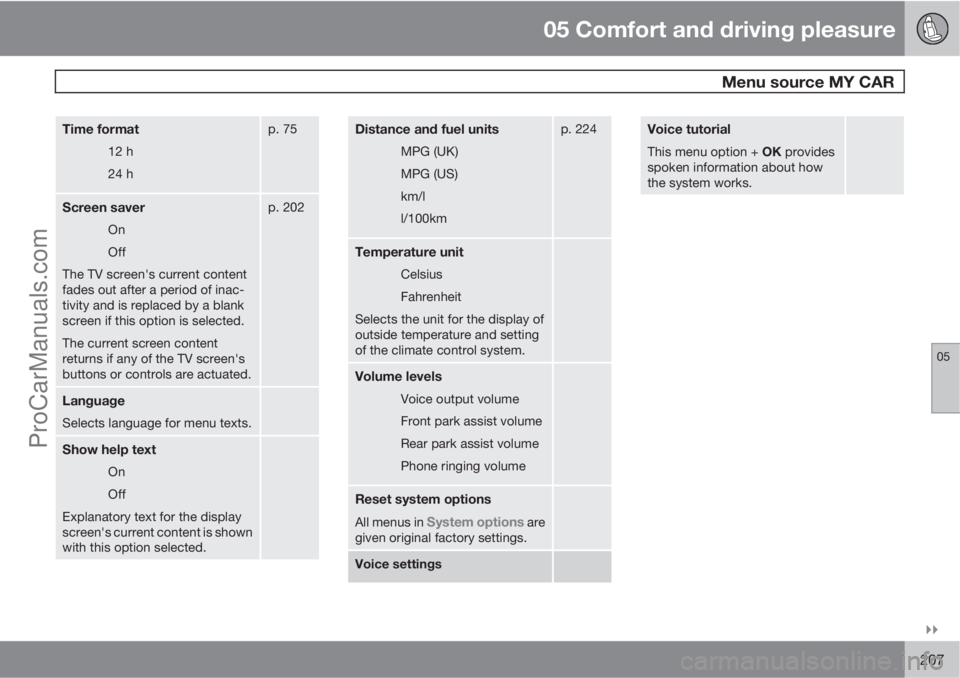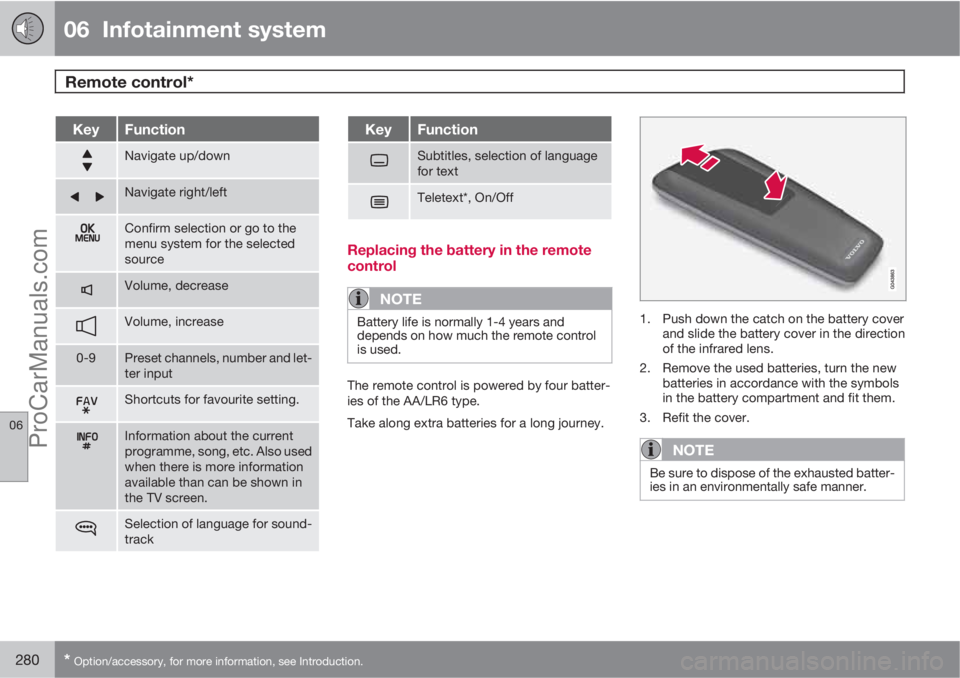Page 209 of 422

05 Comfort and driving pleasure
Menu source MY CAR
05
��
207
Time format
12 h
24 h
p. 75
Screen saver
On
Off
The TV screen's current content
fades out after a period of inac-
tivity and is replaced by a blank
screen if this option is selected.
The current screen content
returns if any of the TV screen's
buttons or controls are actuated.
p. 202
Language
Selects language for menu texts.
Show help text
On
Off
Explanatory text for the display
screen's current content is shown
with this option selected.
Distance and fuel units
MPG (UK)
MPG (US)
km/l
l/100km
p. 224
Temperature unit
Celsius
Fahrenheit
Selects the unit for the display of
outside temperature and setting
of the climate control system.
Volume levels
Voice output volume
Front park assist volume
Rear park assist volume
Phone ringing volume
Reset system options
All menus in System options are
given original factory settings.
Voice settings
Voice tutorial
This menu option + OK provides
spoken information about how
the system works.
ProCarManuals.com
Page 253 of 422

06 Infotainment system
Radio
06
251
Advanced settings
DAB to DAB link
DAB to DAB linking means that the DAB radio
can go from one channel with poor or no recep-
tion to the same channel in another channel
group with better reception. There may be a
certain delay when changing channel group.
There may be a period of silence between the
current channel no longer being available to the
new channel becoming available.
The function can be activated/deactivated in
DAB mode under DAB menu
Advanced
settings
DAB linking.
Wavelength
DAB can be transmitted on two6 wavelengths:
•Band III - covers most areas.
•LBand - available only in a few areas.
By selecting for example
Band III on its own,
channel programming takes place more
quickly than if both
Band III and LBand have
been selected. It is not certain that all channel
groups will be found. Wavelength selection
does not affect the stored memories.
Wavelengths can be deactivated/activated in
DAB mode under DAB menu
Advanced
settings
DAB band.
SubchannelSecondary components are usually named
subchannels. These are temporary and can
contain e.g. translations of the main pro-
gramme into other languages.
If one or more subchannels are broadcast then
the
symbol is shown to the left of the chan-
nel name in the TV screen. A subchannel is
indicated by the
- symbol appearing to the left
of the channel name in the TV screen.
Press
to access the subchannels.
Subchannels can only be accessed on the
selected main channel and not on any other
channel without selecting it.
Display of subchannels can be deactivated/
activated in DAB mode under DAB menu
Advanced settingsSub channels
Programme type textSome radio stations broadcast information
about programme type and programme cate-
gory, for information on Programme types –
PTY, see page 248. This information is shown
on the TV screen.
The function is activated/deactivated in DAB
mode under DAB menu
Advanced
settings
Show PTY text.
Resetting the DAB settingsAll DAB settings can be reset to the original
factory settings.
–The reset is carried out in DAB mode under
DAB menu
Advanced settings
Reset all DAB settings.
6Not all areas/countries use both wavelengths.
ProCarManuals.com
Page 273 of 422

06 Infotainment system
Voice recognition* mobile phone
06
* Option/accessory, for more information, see Introduction.271 General
The infotainment system's voice recognition1
allows the driver to voice-activate certain func-
tions in a Bluetooth�Ÿ-connected mobile phone
or in Volvo's navigation system - RTI (Road and
Traffic Information System).
NOTE
•The information in this section
describes the use of voice commands
to control a mobile phone connected
using Bluetooth
�Ÿ. For detailed infor-
mation on using a mobile phone con-
nected using Bluetooth
�Ÿ with the car's
Infotainment system see page 262.
•The Volvo navigation system RTI (Road
and Traffic Information System) has a
separate user manual which contains
more information on voice control and
voice commands to control that sys-
tem.
Voice commands offer convenience and help
the driver to avoid being distracted, and
instead concentrate on driving and focus
attention on the road and traffic conditions.
WARNING
The driver always holds overall responsibil-
ity for driving the vehicle in a safe manner
and complying with all applicable rules of
the road.
The voice recognition system allows the driver
to voice-activate certain functions of a
Bluetooth
�Ÿ-connected mobile phone and in
Volvo's navigation system - RTI (Road and
Traffic Information System), while the driver
can keep his/her hands on the wheel at the
same time. The input data are in dialogue form
with spoken commands from the user and ver-
bal replies from the system. The voice recog-
nition system uses the same microphone as
the Bluetooth
�Ÿ handsfree system (see illustra-
tion on page 262) and the voice recognition
system's replies come via the car's speakers.
Language
Language list.
Voice recognition is not possible for all lan-
guages. Languages available for voice recog-
nition are marked with an icon in the language
list -
. Changing the language is performed
in the menu system MY CAR, see page 204.
1Only applies to vehicles equipped with Volvo's navigation system - RTI (Road and Traffic Information System).
ProCarManuals.com
Page 282 of 422

06 Infotainment system
Remote control*
06
280* Option/accessory, for more information, see Introduction.
KeyFunction
Navigate up/down
Navigate right/left
Confirm selection or go to the
menu system for the selected
source
Volume, decrease
Volume, increase
0-9Preset channels, number and let-
ter input
Shortcuts for favourite setting.
Information about the current
programme, song, etc. Also used
when there is more information
available than can be shown in
the TV screen.
Selection of language for sound-
track
KeyFunction
Subtitles, selection of language
for text
Teletext*, On/Off
Replacing the battery in the remote
control
NOTE
Battery life is normally 1-4 years and
depends on how much the remote control
is used.
The remote control is powered by four batter-
ies of the AA/LR6 type.
Take along extra batteries for a long journey.
1. Push down the catch on the battery cover
and slide the battery cover in the direction
of the infrared lens.
2. Remove the used batteries, turn the new
batteries in accordance with the symbols
in the battery compartment and fit them.
3. Refit the cover.
NOTE
Be sure to dispose of the exhausted batter-
ies in an environmentally safe manner.
ProCarManuals.com